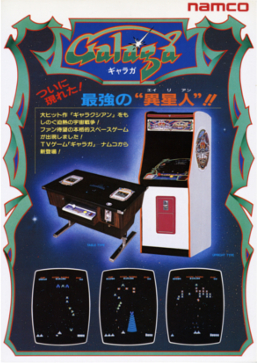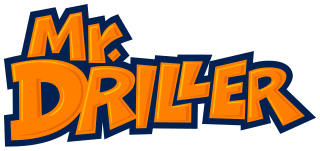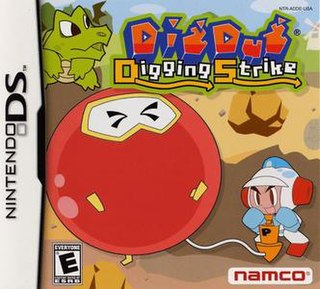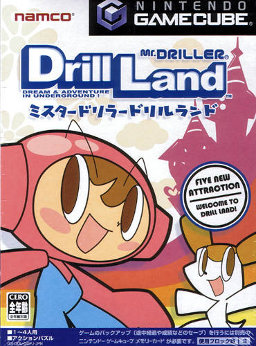
Dr. Mario is a 1990 puzzle video game developed and published by Nintendo for the Nintendo Entertainment System, Famicom, and Game Boy. It was produced by Gunpei Yokoi and designed by Takahiro Harada. The soundtrack was composed by Hirokazu Tanaka.

Galaga is a 1981 fixed shooter arcade video game developed and published by Namco. In North America, it was released by Midway Manufacturing. It is the sequel to Galaxian (1979), Namco's first major video game hit in arcades. Controlling a starship, the player is tasked with destroying the Galaga forces in each stage while avoiding enemies and projectiles. Some enemies can capture a player's ship via a tractor beam, which can be rescued to transform the player into a "dual fighter" with additional firepower.

Dig Dug is a maze arcade video game released by Namco in 1982. It was distributed in North America by Atari, Inc. The player digs underground tunnels to attack enemies in each level, by either inflating them to bursting or crushing them underneath rocks.

Pac-Man Vs. is a 2003 maze video game developed by Nintendo and published by Namco for the GameCube. In the game, one player takes control of Pac-Man, who must eat all of the pellets in the maze, while the others control the ghosts to try to catch them. The objective is to be the first to reach a set number of points, selected before the game begins. The player controlling Pac-Man uses the Game Boy Advance to play, while the others use the television to control the ghosts. The game requires the GameCube - Game Boy Advance link cable in order to play.

Pokémon Pinball: Ruby & Sapphire is a 2003 pinball game developed by Jupiter and published by The Pokémon Company and Nintendo for the Game Boy Advance handheld game console. It was first revealed at E3 2003. The North American release was done to coincide with the fifth anniversary of the North American release of Pokémon Red and Blue. It is based on Pokémon Ruby and Sapphire, and is a sequel to Pokémon Pinball for the Game Boy Color. In some ways, it plays like a traditional pinball game, where the objective is to get a high score by keeping the ball in play as long as possible and hitting bumpers. In keeping with the theme of Pokémon, it features Pokémon collection, where while the players play pinball, they must also capture the eponymous creatures.

Mr. Driller is a puzzle video game franchise created by Yasuhito Nagaoka and Hideo Yoshizawa for Namco. The eponymous first game was released in 1999 for arcades and several home consoles, such as the PlayStation. Gameplay in the series consists of controlling Susumu Hori, the titular Mr. Driller, or one of his friends and destroying colorful formations of blocks to make it to the bottom of a well. In order to survive, players need to collect air capsules to replenish their depleting oxygen and avoid being crushed by falling blocks.

Mr. Driller Drill Spirits is a 2004 puzzle video game developed and published by Namco for the Nintendo DS. Controlling one of six characters, the player must make it to the bottom of each stage by destroying, colored formations of blocks while preventing their oxygen meter from depleting. Multiple different gamemodes are present, including a single-player campaign, a time-attack mode, and a competitive multiplayer mode. It is the sixth entry in the Mr. Driller series.

Pac-Attack, also known as Pac-Panic, is a 1993 falling-tile puzzle video game developed and published by Namco for the Super Nintendo Entertainment System and Sega Genesis. Versions for the Game Boy, Game Gear and Philips CD-i were also released. The player is tasked with clearing out blocks and ghosts without them stacking to the top of the playfield — blocks can be cleared by matching them in horizontal rows, while ghosts can be cleared by placing down a Pac-Man piece that can eat them. It is the first game in the Pac-Man series to be released exclusively for home platforms.

The Tower of Druaga is a 1984 arcade action role-playing maze game developed and published in Japan by Namco. Controlling the golden-armored knight Gilgamesh, the player is tasked with scaling 60 floors of the titular tower in an effort to rescue the maiden Ki from Druaga, a demon with eight arms and four legs, who plans to use an artifact known as the Blue Crystal Rod to enslave all of mankind. It ran on the Namco Super Pac-Man arcade hardware, modified with a horizontal-scrolling video system used in Mappy.

Mario Golf: Advance Tour is a role-playing video game-styled sports game developed by Camelot Software Planning and published by Nintendo for the Game Boy Advance in 2004. The game is the sequel to the Game Boy Color version of Mario Golf and the Game Boy Advance counterpart of Mario Golf: Toadstool Tour.

Dig Dug: Digging Strike is a 2005 maze video game published by Namco for the Nintendo DS. In Europe, the game was published by Atari Europe. It is the fifth entry in the Dig Dug video game series, and the second to be made for a home platform. The game follows series protagonist Taizo Hori, bitter about his son Susumu getting more attention than him—after a chain of tropical islands is threatened by monsters, Taizo sets out to defeat them and reclaim his fame. Gameplay combines mechanics established in the original Dig Dug and its sequel Dig Dug II, centered around sinking a large "boss" character into the ocean by digging under large stakes in the ground.

Digimon Racing is a racing video game developed by Griptonite Games and published by Bandai for the Game Boy Advance. Part of the Digimon media franchise and video game series, it utilizes Digimon's characters and elements. Its gameplay largely resembles that of traditional racing games, but also utilizes elements of kart racing and action games. Its eleven playable characters can be increased to over 40 via Digivolution.

Mr. Driller Drill Land is a 2002 puzzle video game developed and published in Japan by Namco for the GameCube. It is the fifth entry in the Mr. Driller video game series, and the second developed for a Nintendo platform following Mr. Driller A. Controlling one of seven characters, the player must make it to the bottom of each stage by destroying colored blocks, which can connect to each other and form chain reactions. The game is divided into five different modes themed as amusement park attractions, which feature new mechanics such as enemies, items and different block types.

Mr. Driller Online is a downloadable puzzle video game created by Namco Bandai and released in 2008 for the Xbox 360. It is the fourth game in the Mr. Driller series of puzzle games and re-uses many assets from Mr. Driller Drill Land.

Galaga Legions is a 2008 twin-stick shooter video game developed and released by Namco Bandai Games for the Xbox 360. It is the twelfth game in the Galaxian series, and the third developed for home platforms. The player controls a starship, the AEf-7 "Blowneedle", in its efforts to wipe out the Galaga armada. The objective of the game is to clear each of the five stages as quick as possible. Stages have a heavy emphasis on puzzle solving and chain reactions, which are necessary to clear out enemy formations. The Blowneedle has a pair of satellites at its disposal, and can place them anywhere on the screen to fend off enemies.

Mr. Driller W is a 2009 puzzle video game developed and published for the WiiWare service by Namco Bandai Games. The eighth entry in the Mr. Driller series, gameplay revolves around clearing each level by destroying, or "drilling", large formations of colorful blocks. Players have an oxygen meter that acts as a time limit, and constantly depletes; air is replenished by collecting air capsules, and is depleted further by destroying brown "X" blocks.

Star Trigon is a 2002 puzzle arcade game published in Japan by Namco. Ports for iPod, iOS devices and Windows were also released. In the game, the player controls one of three characters — Wataru Hoshi, Chuta Bigbang and Susumu Hori — the objective being to rescue creatures known as "Uchijins" by hopping from planet to planet to draw triangles and capture them. The player will automatically circle the planet they are on, requiring timed jumps to avoid falling off the playfield. It ran on the Namco System 10 hardware.

Mr. Driller is a 1999 puzzle arcade game developed and published by Namco. Versions for the PlayStation, Dreamcast, Microsoft Windows, Game Boy Color, WonderSwan Color, mobile phones, and iOS were also released. Controlling Susumu Hori, the titular "Mr. Driller", the player must dig their way to the bottom of the screen by destroying colored blocks that litter the playfield. Blocks will be cleared if four or more are touching each other, which can be used to cause chain reactions. Susumu has a constantly-depleting oxygen meter that can be refilled by collecting air capsules found throughout stages.

Mr. Driller G is a 2001 puzzle arcade game developed and released in Japan by Namco for its System 10 hardware. It is the third installment in its Mr. Driller series, and the last released for arcades. Controlling one of seven characters, players must make it to the bottom of the level by destroying colorful formations of blocks. G introduces several new ideas to the series, such as power-ups, a story campaign, and online multiplayer.

Mr. Driller A is a 2002 puzzle video game developed and published in Japan by Namco for the Game Boy Advance. The fourth installment in its Mr. Driller series, players control one of seven characters and must make it to the bottom of the level by destroying colorful formations of blocks. A adds several new mechanics to the gameplay of its predecessors, such as a virtual pet named the "Pacteria" that players can grow and care for.




















